Rothenburg ob der Tauber feels like a storybook come to life. Every corner has medieval walls, charming cobbled streets, and those half-timbered houses that almost beg for a photo.
Whenever someone asks about unforgettable things to do in Germany, I always recommend this place for a weekend getaway.
Here are my top 7 things to do in Rothenburg ob der Tauber—blending the town’s unique history, breathtaking views, and local treats like the famous Schneeballen. From strolling the city walls to biting into traditional pastries, this small town somehow packs in so much.
I like to explore at a slower pace, and Rothenburg just makes every experience stick in your memory, whether it’s your first time or you’re coming back for more.
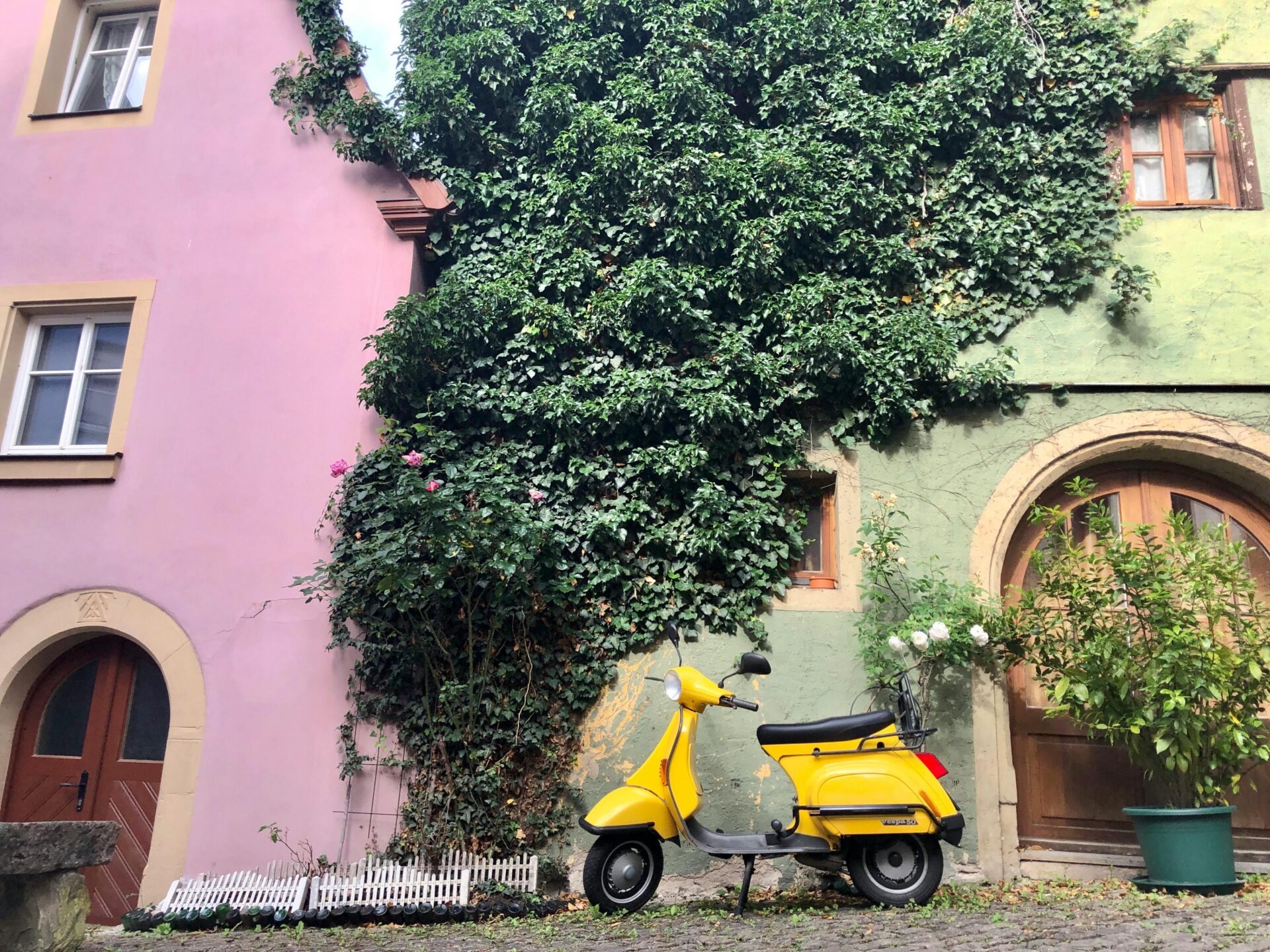
Step Into Rothenburg’s Medieval Old Town
Walking into Rothenburg’s old town honestly feels like wandering into a fairytale. The winding cobblestone lanes, colorful timbered buildings, lively squares, and landmark towers all bring something special for travelers who crave both history and charm.
Exploring the Cobblestone Streets
The cobblestone streets caught my eye and, well, my feet too. Since Rothenburg is one of Germany’s best-preserved medieval towns, walking around on foot meant stumbling into hidden alleyways, quirky shopfronts, and bakeries selling schneeballen.
I love how the streets twist and open into quiet courtyards where locals sip Franconian wine in the shade.
The medieval layout makes it easy to get lost—and honestly, that’s part of the fun. Old Gothic script on street signs really adds to the vibe. The town is compact, so I could wander from the city wall to the river in about thirty minutes.
Sturdy shoes definitely help.
Watching the sunrise bounce off the half-timbered houses became a tiny highlight of my mornings. Even when things got busy, the old stones never lost their charm.
I’d often pause to soak it in and snap a few photos, just to remember the feeling.
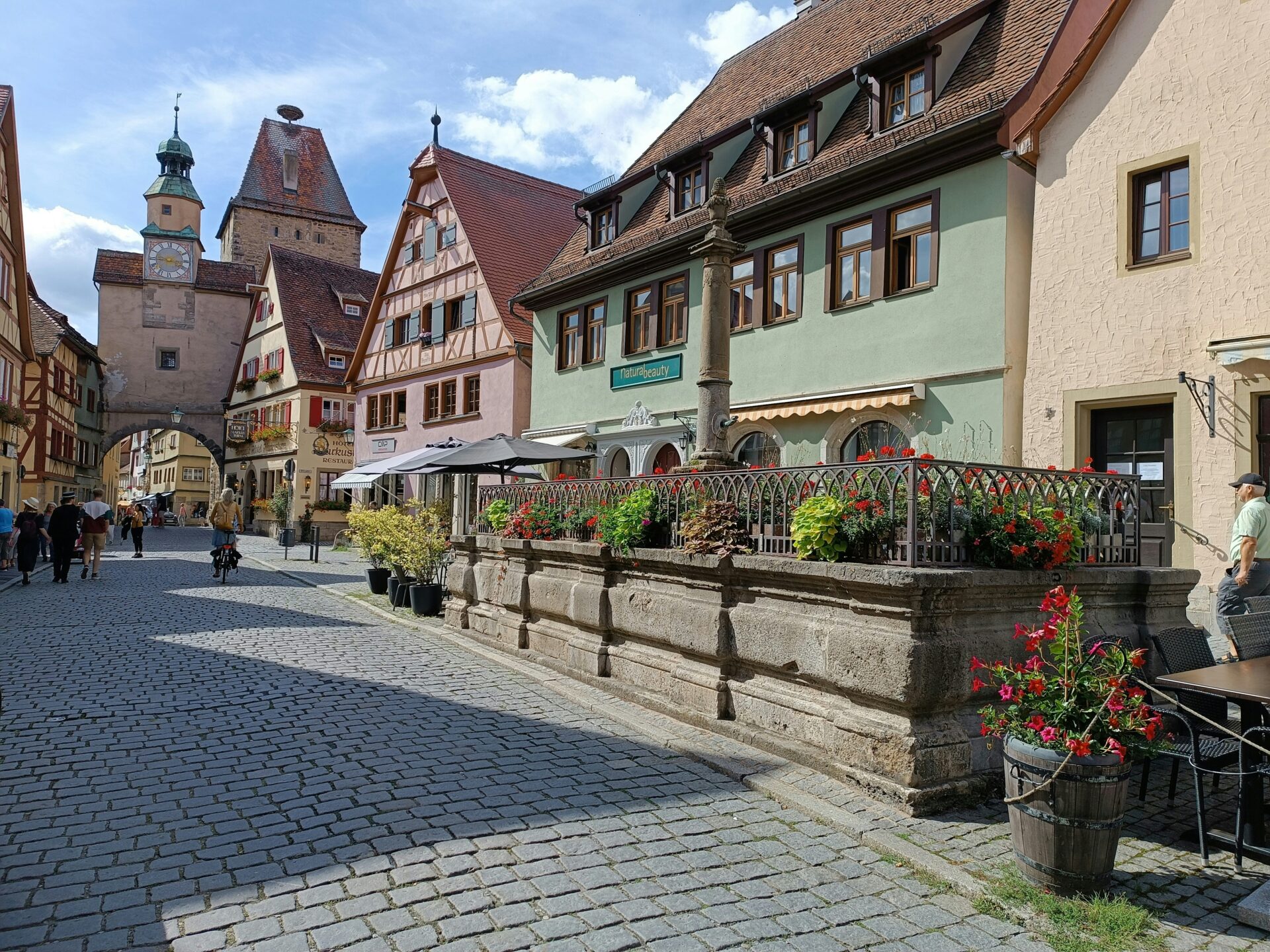
Historic Marktplatz and Town Hall
Marktplatz—the main market square—sits right at the heart of the old town and has buzzed with life since medieval times. The Rathaus (town hall) stands out with its grand mix of Renaissance and Gothic architecture.
I climbed the town hall tower, and the views over tiled rooftops and the Romantic Road stretching into the countryside made every step worth it.
Down in the square, cafes and boutiques fill the air with tempting smells and chatter. I grabbed a glass of local Franconian wine from a street vendor—crisp, light, and perfect for a sunny afternoon.
Right beside the square, the ornate Georgsbrunnen, a 15th-century fountain, once supplied the whole town with water. It’s a cool spot to sit, people-watch, and listen to street musicians.
Marktplatz brims with energy, especially when visitors arrive from places like Nuremberg or Würzburg. I found plenty of spots to slip into the local rhythm—maybe with a pastry or just by soaking up the architecture.
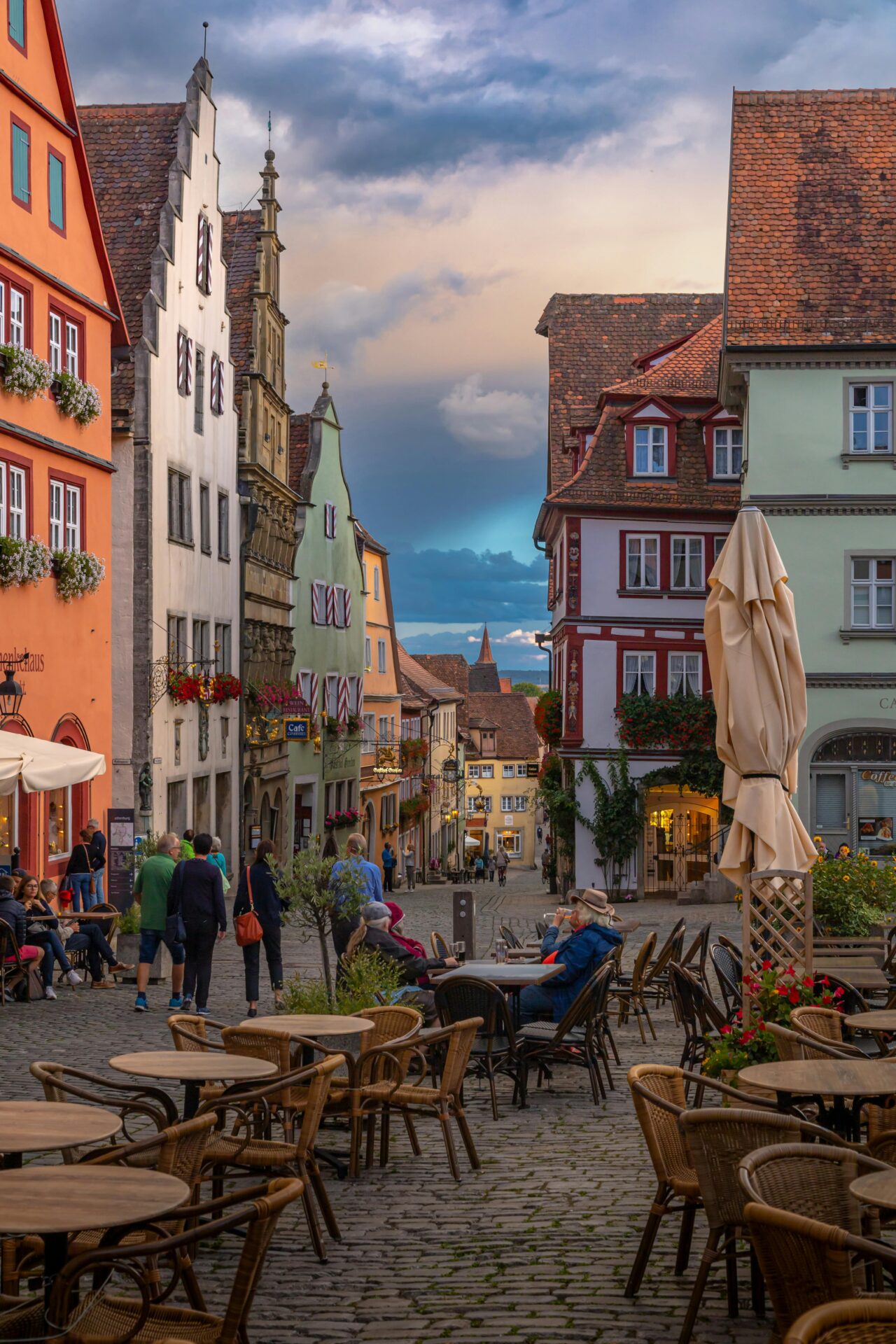
Unforgettable Plönlein Photo Spots
Plönlein is Rothenburg’s most iconic view, and honestly, I stopped here every single time I passed. It’s not just one building, but a postcard-perfect intersection: a tilted yellow house, a half-timbered inn, and two medieval towers overhead.
Early mornings are the best—the light is soft, and the street is almost empty. That’s when you can get photos without crowds.
This spot anchors Rothenburg in my memory. Standing there, it feels like time has paused, and all you see are colorful beams, stacked roofs, and overflowing flower boxes.
Here’s a quick tip for fellow visitors:
| Best Time for Photos | Lighting | Crowds |
|---|---|---|
| Early Morning | Soft, golden hour | Few people |
| Late Afternoon | Warm tones | More busy |
Plönlein isn’t just a photo stop. It marks the start of an adventure, whether you’re heading for the town wall or wandering the quiet lanes of the lower old town.
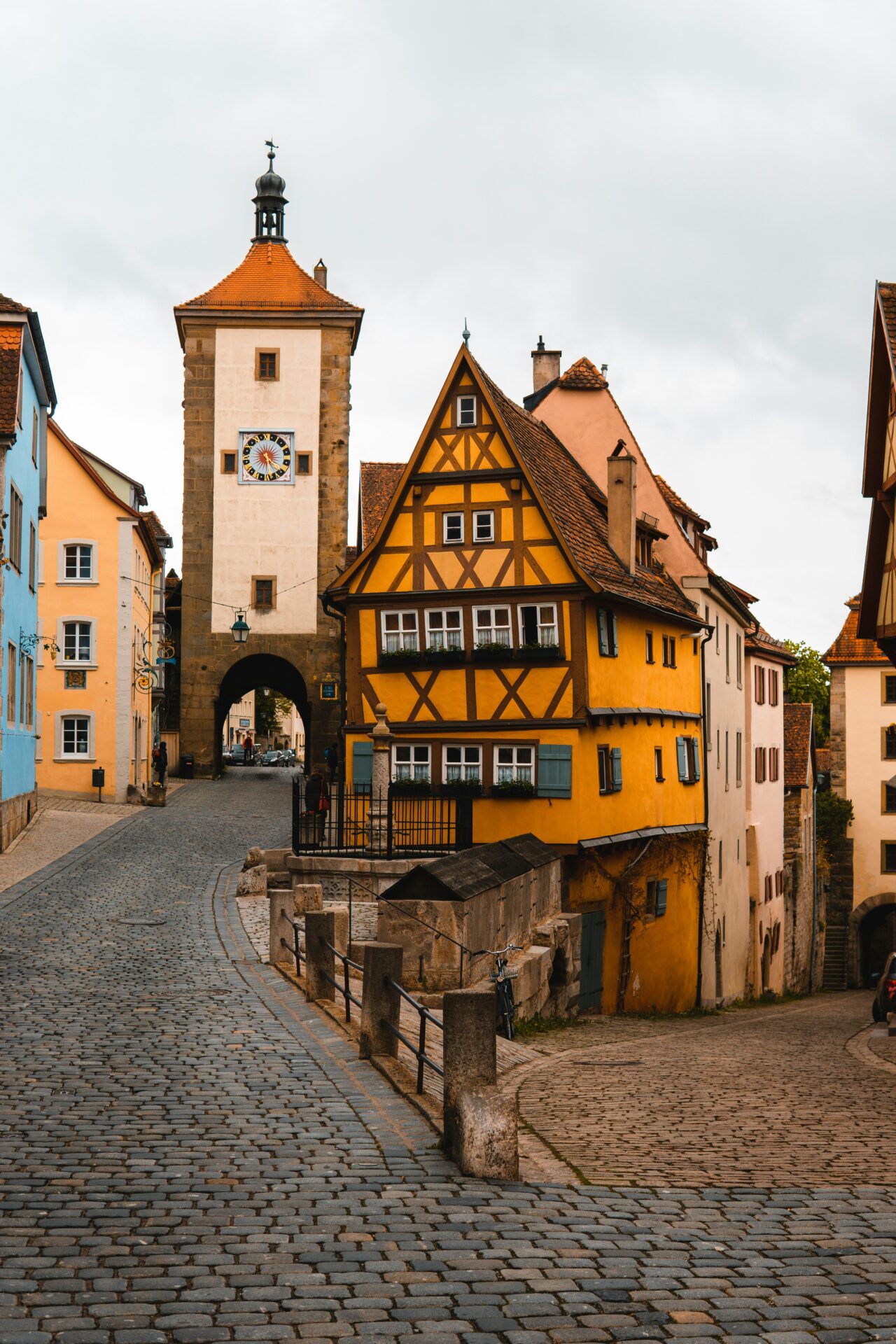
Walking Rothenburg’s Legendary City Walls
Rothenburg ob der Tauber’s city walls stand among the best-preserved medieval fortifications in Germany. The moment I stepped onto the ancient stone walkway, I felt transported into a world of towers, archways, and red roofs stretching out around me.
The Tower Trail Experience
Walking the Tower Trail (Turmweg) is a must. The path stretches about 2.5 kilometers and is open to everyone, free of charge.
I started at the Old Town Square and followed the trail above the city, ducking under wooden beams and peeking out over the ramparts. Along the way, information plaques tell the stories behind each tower, gate, and section.
I loved popping into the ancient towers—each one offers a new view or a quirky bit of Rothenburg’s history.
Wear comfortable shoes. Some stairs are steep and uneven, and a few covered sections of the wall can feel low or narrow.
The Tower Trail works in both rain and shine since most of the walkway is covered by a charming red-tiled roof.
Quick Tips:
- Entry: Free
- Distance: About 2.5 km (1.5 miles)
- Best Start: Marktplatz (Old Town Square)
- End: Saint Wolfgang Church
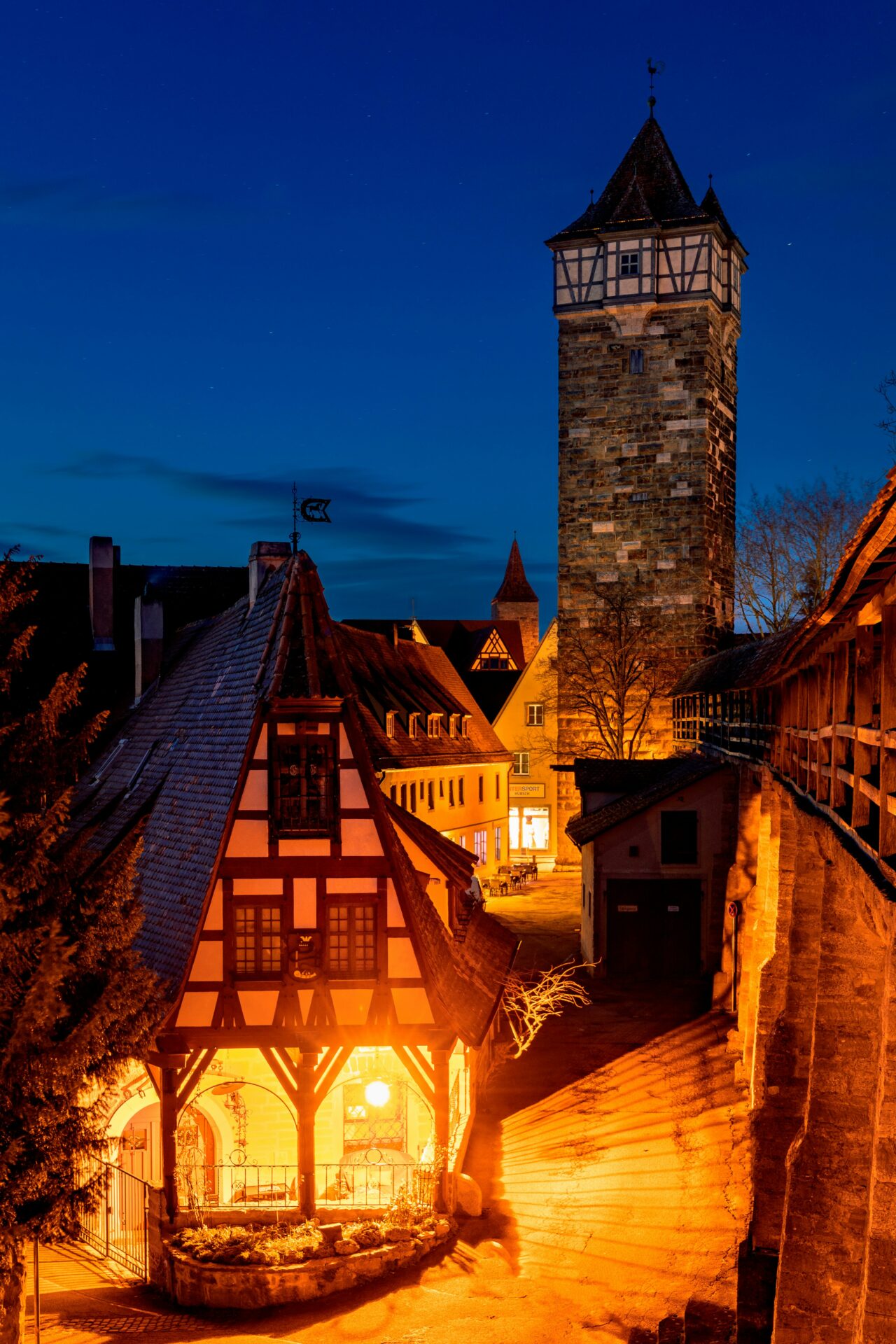
Panoramic Views From Rödertor
Rödertor, at the eastern edge of town, is one of my favorite stops along the wall. Its tall central tower is easy to spot.
Climbing Rödertor gives you some of the best panoramic views in Rothenburg. From the top, the scenery changes completely—you see jumbled roofs, winding alleys, and patchwork fields beyond the city.
It’s the perfect place to pause, take photos, and just admire how the walls have protected Rothenburg for so long.
If the weather’s good, sunrise or sunset at Rödertor feels peaceful and usually uncrowded. Early morning light turns the half-timbered houses golden, and the view of the medieval architecture is pretty special.
I could lose track of time here just watching the town wake up.
The steps to the viewing platform are steep, but there are railings for support. Bring your camera or phone—I’ve snapped some of my best Rothenburg shots right here.
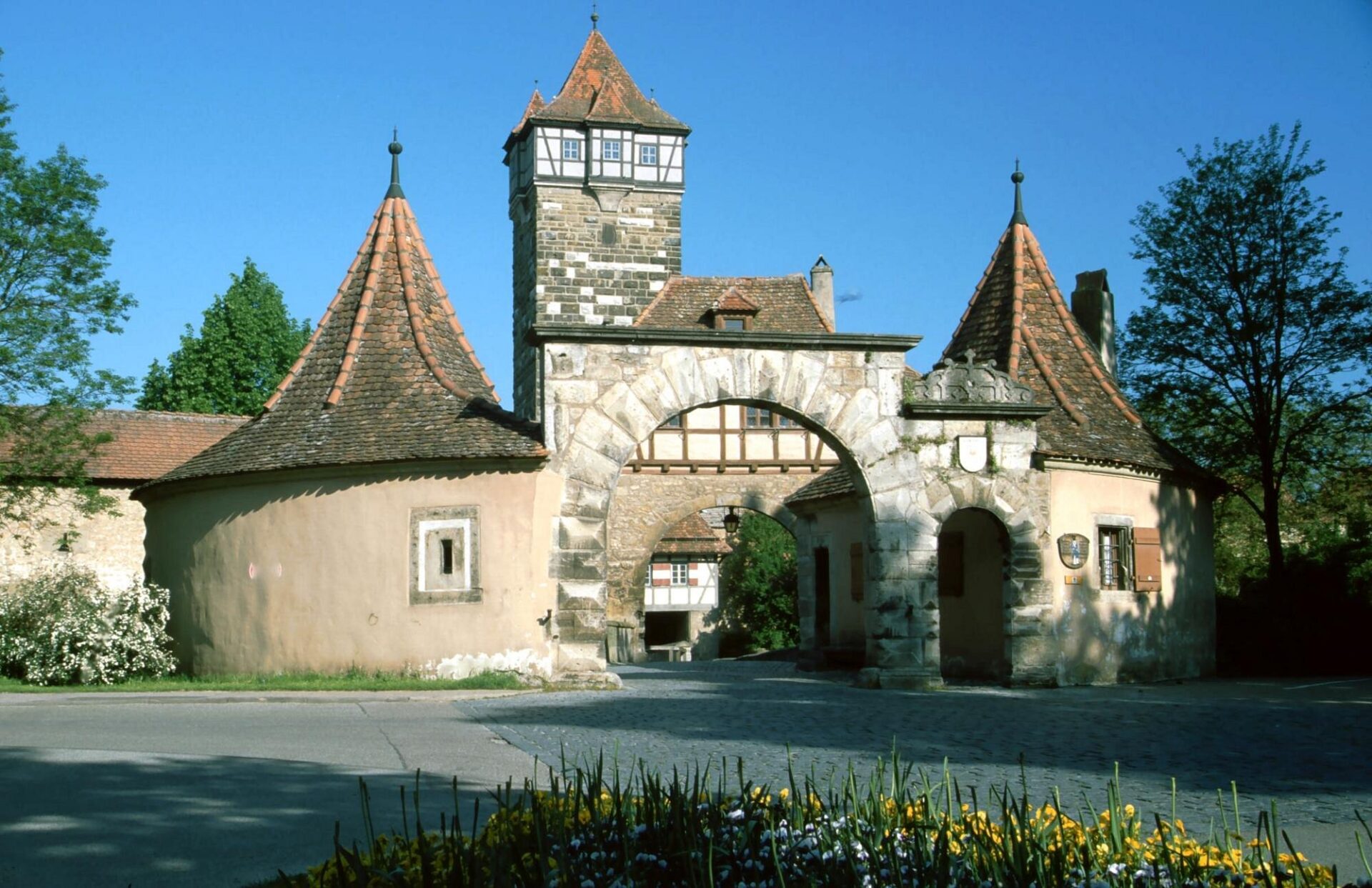
History of the Medieval Walls
Builders started Rothenburg’s city walls way back in the 12th century. The walls protected the town from invaders and bandits and shaped Rothenburg’s story.
During the Thirty Years’ War, the walls and towers kept Rothenburg safe from attacking armies. You can still spot signs of old battles, with arrow slits and fortified towers lining the wall.
Each gate tells a different chapter—like the imposing Rödertor and the rounded towers along the southern stretch, which once guarded valuable trading routes.
Walking here, the medieval architecture feels alive. Thick stonework, timber beams, and narrow watch towers make you feel like you’ve stepped into history.
Along the wall, memorial plaques honor locals who helped restore the ramparts after storms and wars.
Exploring Rothenburg’s city walls gives you a real sense of how people once lived and protected their homes. The details in every archway and battlement turn these fortifications into a living museum above the town’s charming streets.
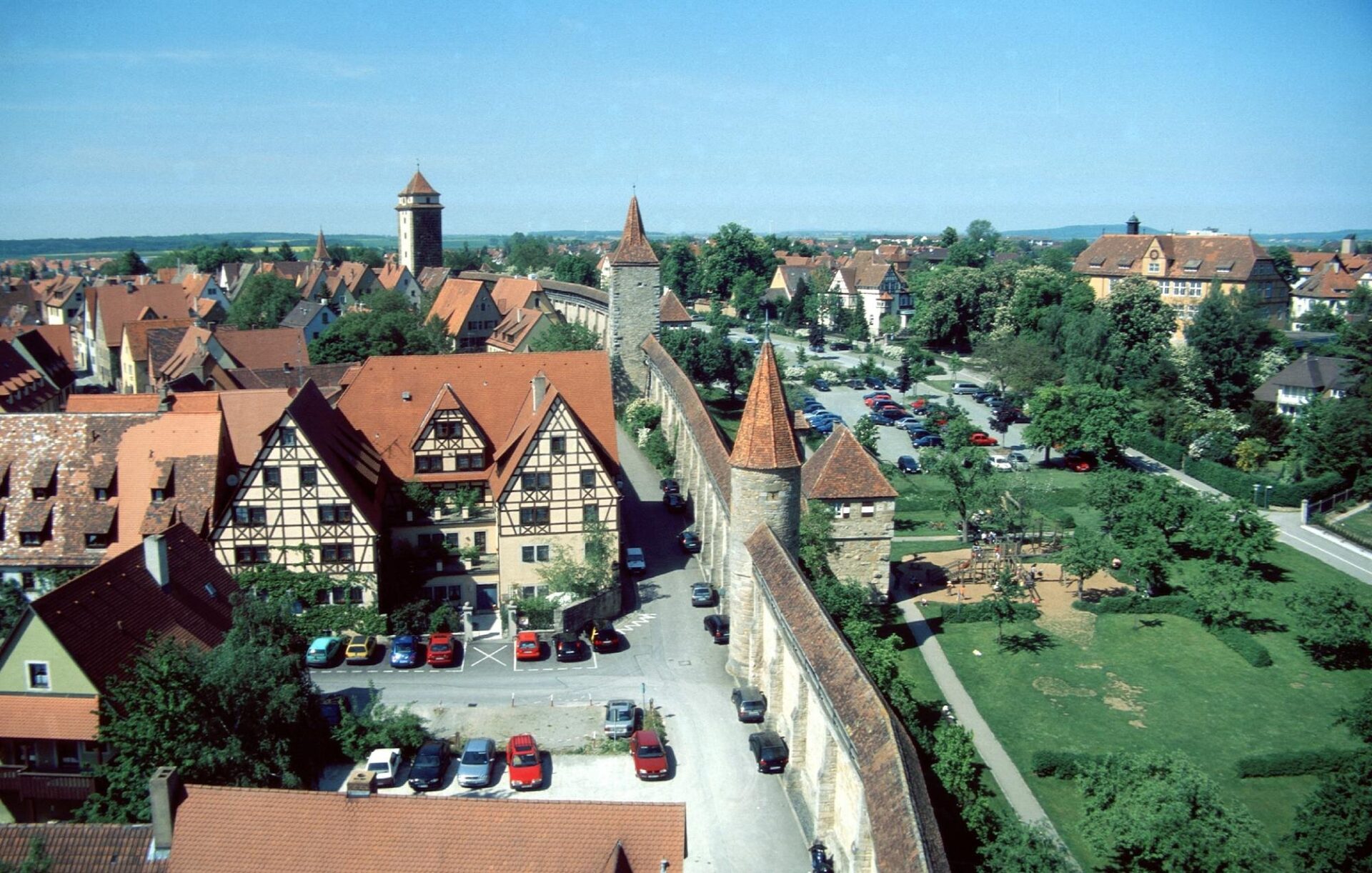
Fascinating Museums & Timeless Traditions
Rothenburg ob der Tauber is a goldmine for anyone who loves history and old European customs. Every corner of the old town holds stories, from chilling tales of medieval justice to warm memories sparked by Christmas traditions and religious art.
Unveiling the Medieval Crime and Justice Museum
The Mittelalterliches Kriminalmuseum (Medieval Crime and Justice Museum) surprised me with how eye-opening—and a bit chilling—it is. Inside, I found original artifacts like iron shackles, punishment masks, and actual town law documents from centuries ago.
One exhibit showed how justice worked in medieval times—often harsh and very public. There were torture instruments, old legal texts, and displays about judging witches and criminals.
It’s fascinating (and slightly unsettling) to see how much society has changed.
The museum also covers the history of law and order in Germany, using real case studies and artifacts. I spent almost two hours here, learning about strange punishments, the power of old guilds, and seeing authentic relics from Rothenburg’s past.
Highlights:
- Original torture devices and court records
- Interactive displays explaining historic trials
- Focus on the evolution of justice throughout the centuries
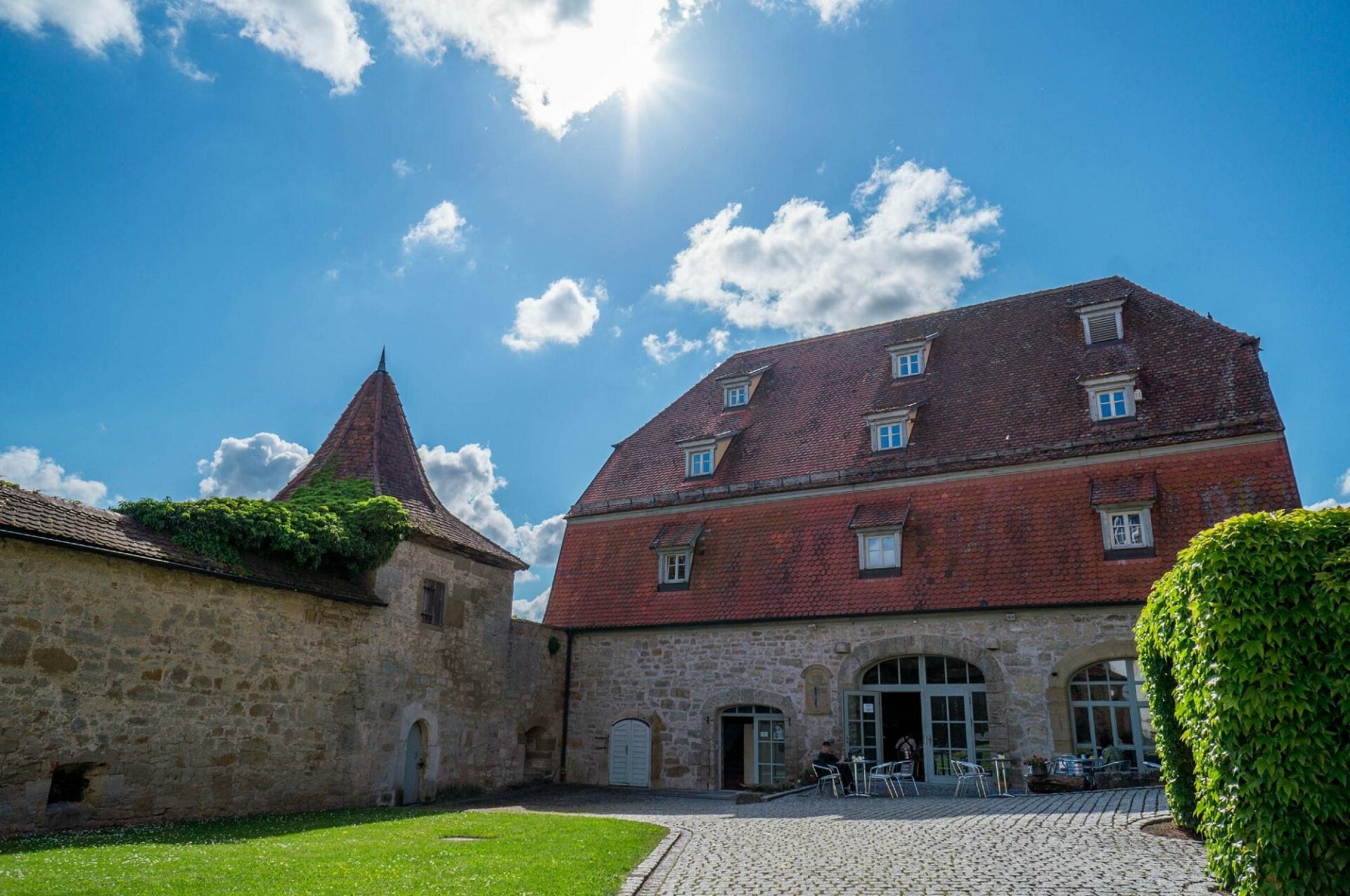
Discovering the German Christmas Museum
Even outside December, the Deutsches Weihnachtsmuseum (German Christmas Museum) inside the Käthe Wohlfahrt building put me right into the Christmas spirit. The rooms are packed with ornaments, nutcrackers, vintage cards, and old Christmas trees covered in candles and hand-blown glass.
The museum tells the story of Christmas traditions—like where Schneeballen, advent calendars, and Christmas pyramids came from. I learned how these customs grew and changed, and the displays go all the way back to the 19th century.
The rooms are organized by theme, with timelines showing how decorations and traditions shifted over the years.
If you love Christmas, this place is magical any time of year.
Don’t miss:
- Antique ornaments and glass baubles from across Germany
- Rare wooden toys and handcrafted Christmas figures
- Original German advent calendars with detailed artwork
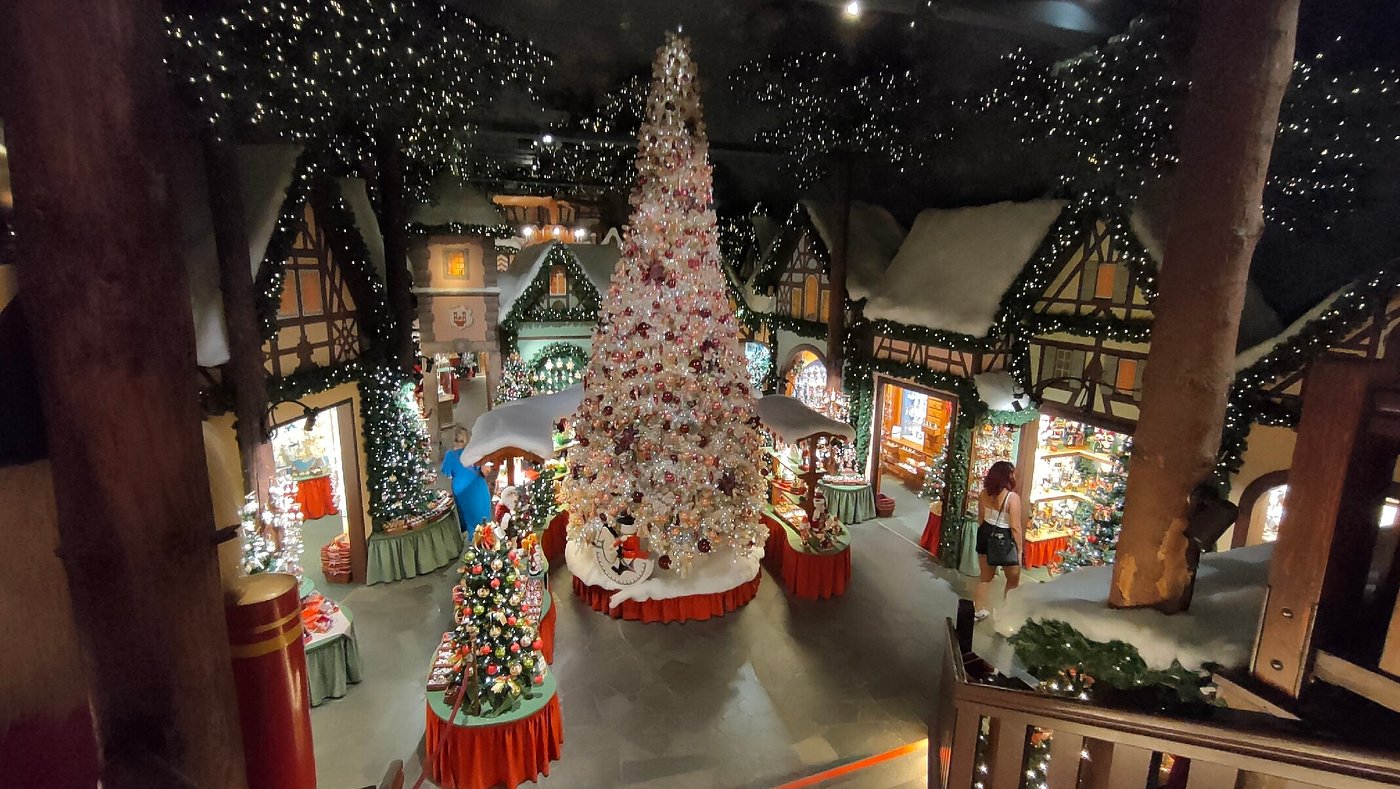
Art and Artifacts at Rothenburg Museum
The Rothenburg Museum, set in a former Dominican convent, is a must if you’re curious about the area’s cultural heritage. As I wandered its quiet, vaulted halls, I spotted stunning religious art, medieval sculptures, and rare manuscripts.
Some altarpieces and carvings date back to the Middle Ages, giving a real sense of the town’s spiritual history.
Upstairs, rooms show daily life in Rothenburg over the centuries with pottery, costumes, and old furniture. Special collections focus on the town’s Jewish community and even a rebuilt medieval kitchen.
Each room opens a window into a different part of life, from sacred rituals to city celebrations.
Key things to see:
- Stained glass windows and golden altarpieces
- Artifacts from daily life—kitchen tools, trade items
- Local history exhibits highlighting Rothenburg’s place in Franconia
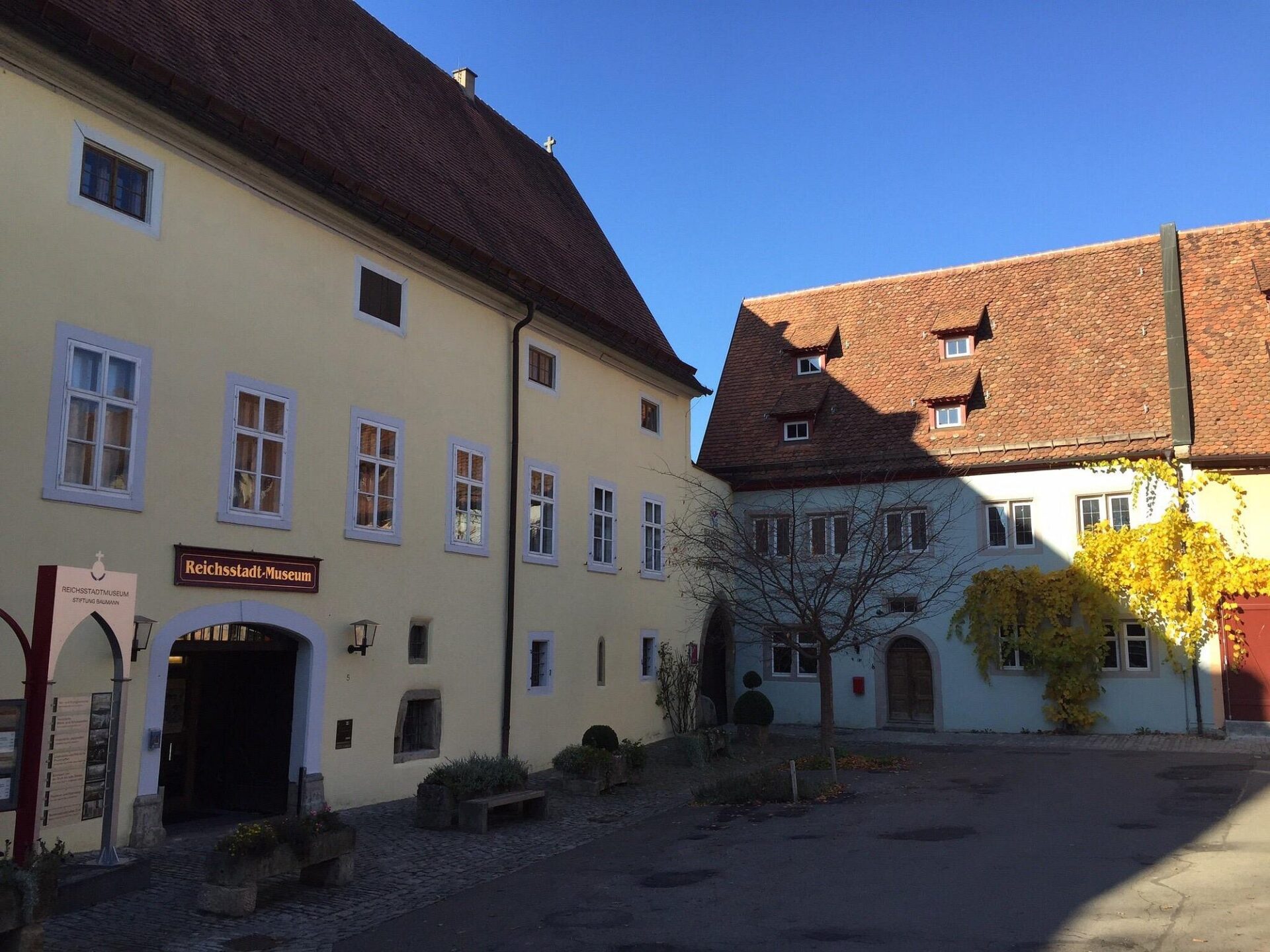
Immersive Tours: Walking, Stories, and Night Watchmen
Exploring Rothenburg ob der Tauber feels like stepping into a living history book. Every cobblestone path, hidden alley, and ancient wall hides stories just waiting to be discovered on foot.
Guided Walking Tours and Day Trips
When I first arrived in Rothenburg, I signed up for a walking tour. It was honestly the best way to get my bearings.
The guides dove right into the town’s backstory, explaining how Rothenburg became an imperial free city and what daily life looked like in its medieval days. Most tours kick off in the market square and meander through old lanes, passing spots like St. Jakob’s Church and the busy Plönlein.
I really enjoyed hearing about the Camino de Santiago trail. It runs straight through Rothenburg, which is perfect if you’re into pilgrimage history like I am.
If you want more flexibility, you can set up day trips at the tourist info center. They’ll help you bundle sights or even mix a wall walk with other attractions.
Honestly, walking the intact city walls and spotting the town’s 42 towers gave me a whole new appreciation for Rothenburg’s defenses and what daily life must have been like.
If you’re hunting for tips, pop by the tourist information desk—they’ll have the latest schedules and themed tours. Some guides focus on architecture, while others dive into Rothenburg’s trading past.
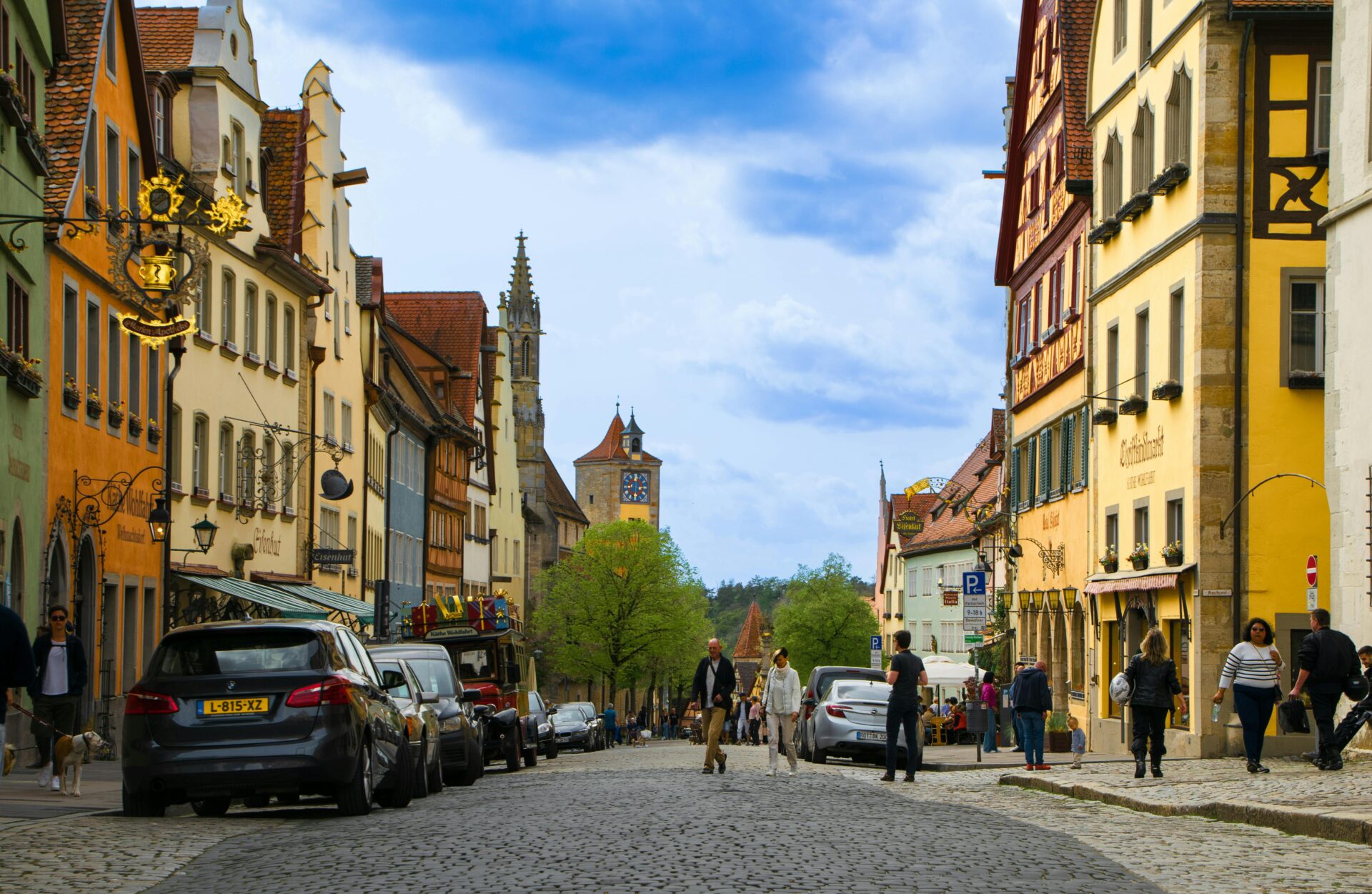
Joining the Famous Night Watchman Tour
One memory that really sticks with me is the Night Watchman Tour at dusk. As evening falls, the night watchman—lantern swinging, cloak billowing—leads a group through the shadowy streets.
The vibe changes after dark; everything feels a bit more mysterious as you hear stories about the Thirty Years’ War and old city traditions.
The guide told us how watchmen protected Rothenburg at night. They’d keep the peace, guard against fires, and watch for intruders.
I picked up all sorts of tidbits about curfews, city rules, and how the defenses worked when trouble came knocking.
Why it stands out:
- True storytelling: The guide mixes humor and history, so it’s easy to picture medieval life.
- Interactive: You can ask questions, and the route winds through hidden corners.
- Ending in the market square: I left feeling like I’d just stepped out of a storybook.
For me, this tour made Rothenburg’s past feel real in a way guidebooks just can’t. If you like legends, quirky facts, and local traditions, don’t skip it.
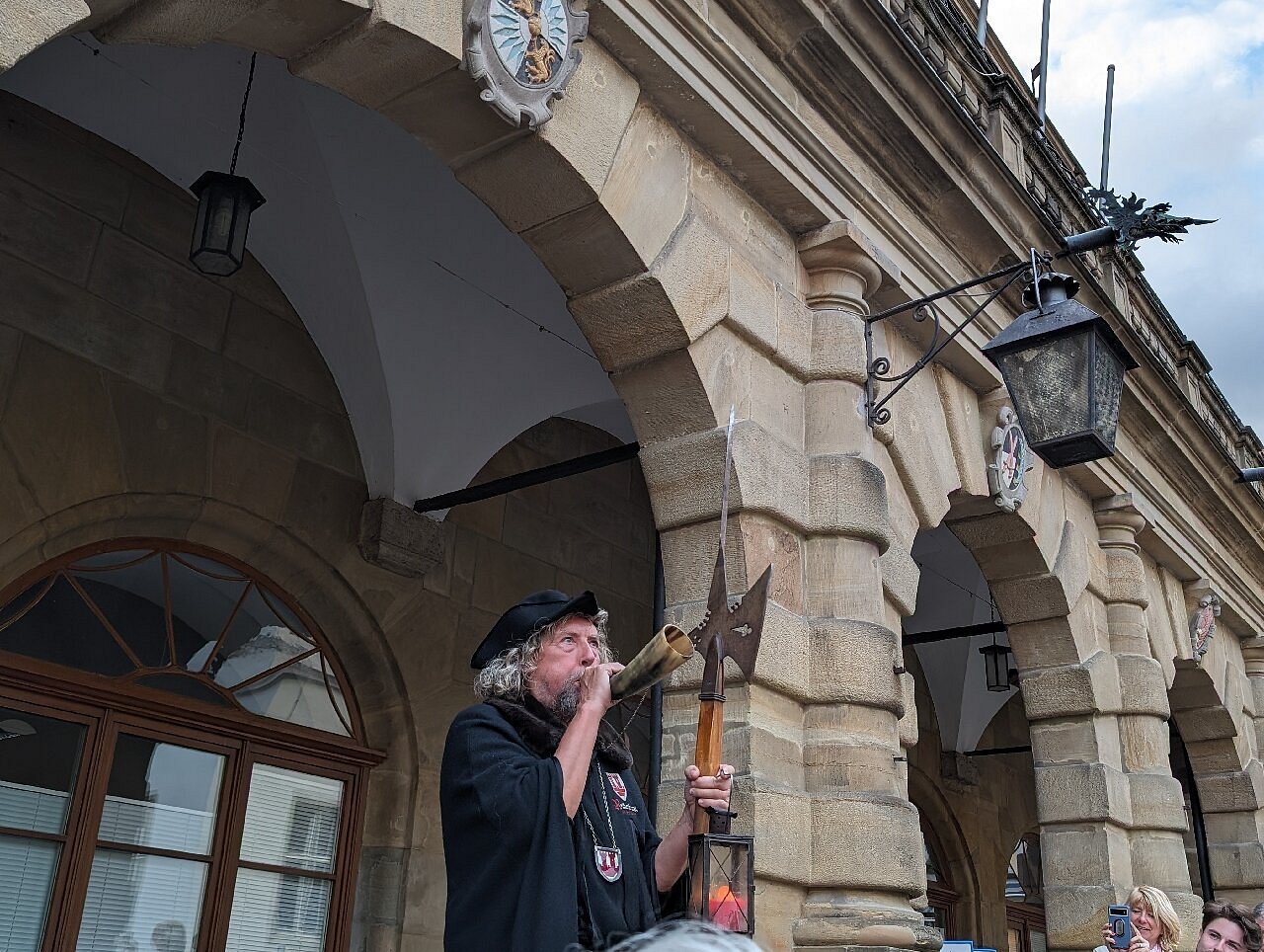
Iconic Sites and Hidden Gems in Rothenburg
Rothenburg’s towers rise above cobbled streets, while tucked-away gardens and little cafés add unexpected charm. I love wandering between grand Gothic churches and peaceful medieval courtyards, searching for both the big sights and the quiet corners.
St. Jakob’s Church and the Holy Blood Altarpiece
When I step inside St. Jakob’s Church, the soaring Gothic arches and the gentle hush always strike me. Built between 1311 and 1484, the church’s detailed architecture and stained glass really steal the show.
The Holy Blood Altarpiece by Tilman Riemenschneider stands in the western choir and draws a crowd for good reason. The wood carvings tell biblical stories, but what really gets people talking is the crystal reliquary at the center—supposedly holding a drop of Christ’s blood.
I’d suggest lingering here, just soaking up the details and the calm. If you’re lucky, you might catch an organ concert, which adds something special to the whole experience.
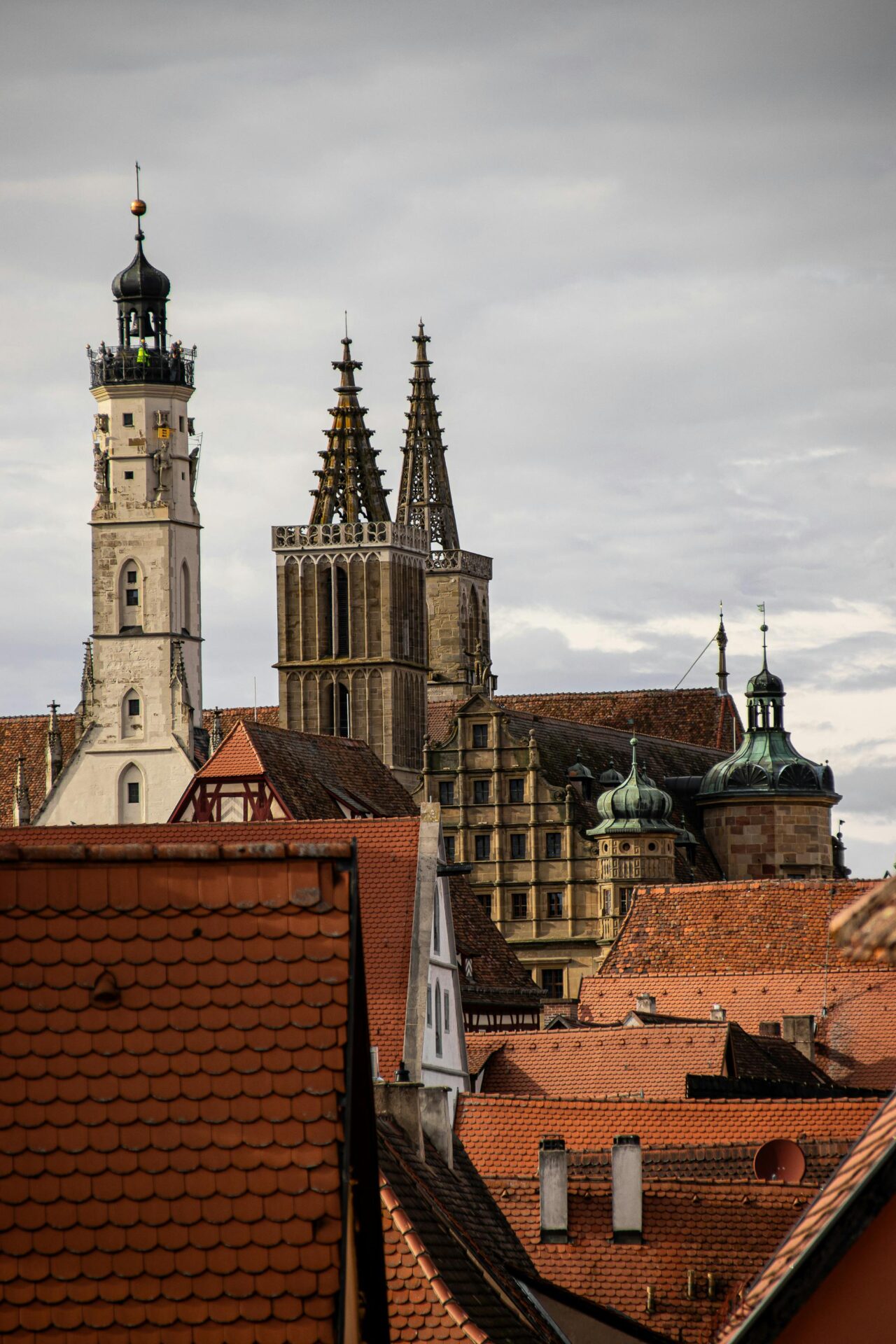
The Beauty of Burggarten and Castle Garden
Just a short walk from the center, the Burggarten (Castle Garden) offers a peaceful break from the crowds. It sits on Rothenburg’s western edge, where a castle once stood.
Now you’ll find manicured lawns, blooming flowers, and plenty of shade for hot afternoons.
The panoramic view over the Tauber Valley is easily my favorite part. I like to stand by the edge, just staring out at the river and rooftops—honestly, it’s a great photo spot.
Benches are scattered around, so you can sit and breathe in the roses or just rest your feet.
Near one entrance, I always spot statues of the four seasons. They add a bit of whimsy to the tidy hedgerows and fountains.
The garden’s quiet paths are perfect for reflecting after a busy day in the main square.

Schmiedgasse and Judengasse Discoveries
Walking down Schmiedgasse, I feel like every turn reveals something new—colorful half-timbered houses, quirky shops, and cozy bakeries line the street. It’s my go-to place for window shopping and people-watching.
At the top, the Ratstrinkstube clock draws a little crowd each hour for its mechanical show.
Turn onto Judengasse, the old Jewish quarter, and suddenly history feels much closer. Stone plaques remember the families who once lived here, and it’s way quieter than the market square.
I like to wander these narrow lanes early in the morning, when sunlight turns the stonework a warm gold.
Here’s a quick Tip Table for exploring:
| Street | Highlights |
|---|---|
| Schmiedgasse | Shops, Ratstrinkstube clock |
| Judengasse | Jewish history, quiet lanes |
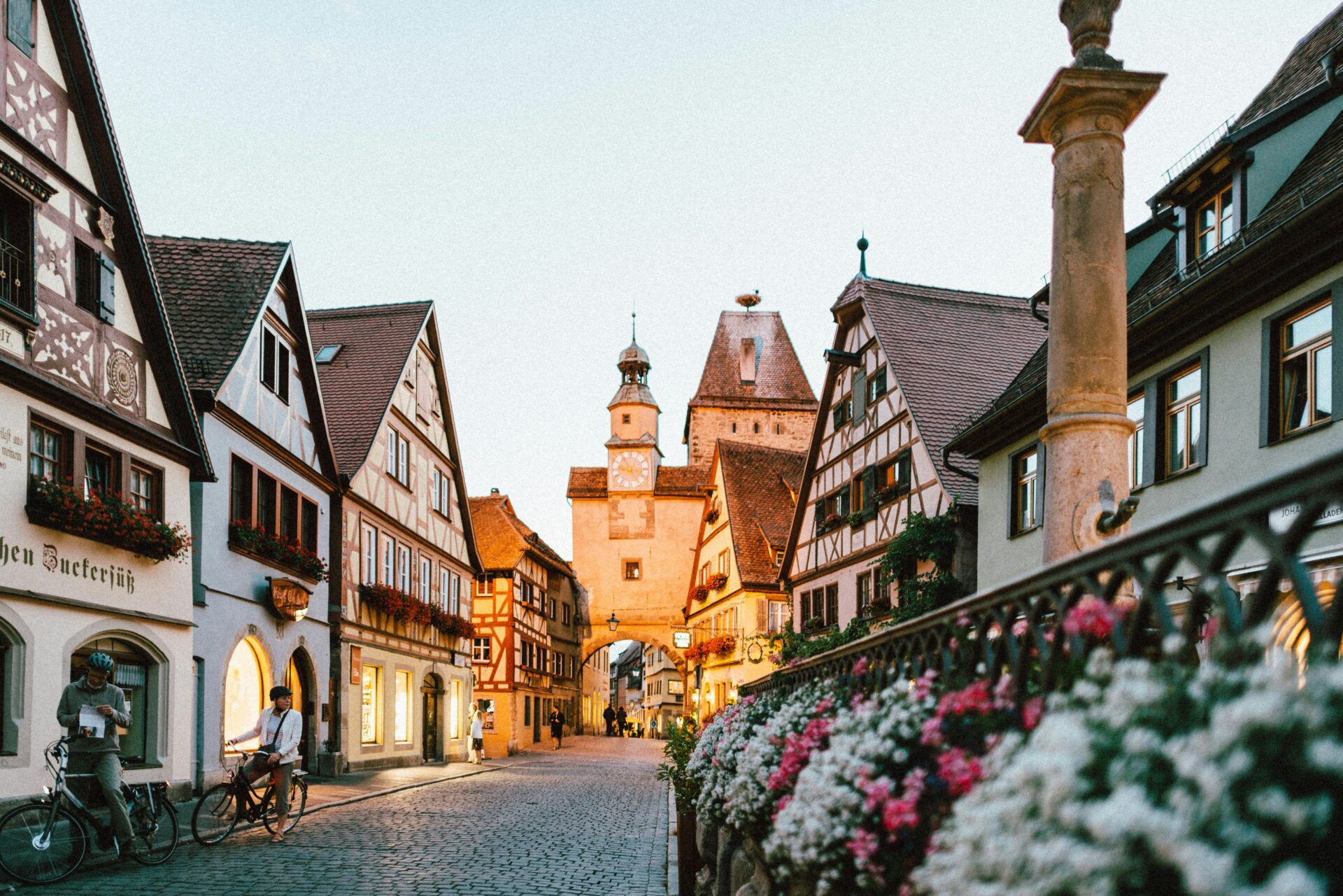
Local Eats: Zur Höll and Outdoor Cafés
Food is always a highlight when I’m in Rothenburg. For something different, I often head to Zur Höll, which claims to be one of the oldest taverns in town.
It’s tucked inside a crooked medieval building, and the menu is packed with local favorites—Franconian sausages, sourdough bread, and hearty pork dishes.
If the weather’s good, I can’t resist sitting at one of the outdoor cafés on the main square or along a side street. Watching people stroll by and gazing at the historic buildings just makes lunch better.
Don’t skip the Schneeball—a local pastry that’s crumbly, sweet, and often dusted with sugar or dipped in chocolate. You’ve got to try it at least once.
Most cafés offer outdoor seats, so I always pause for a coffee, listening to the town clock and the gentle buzz of conversation.
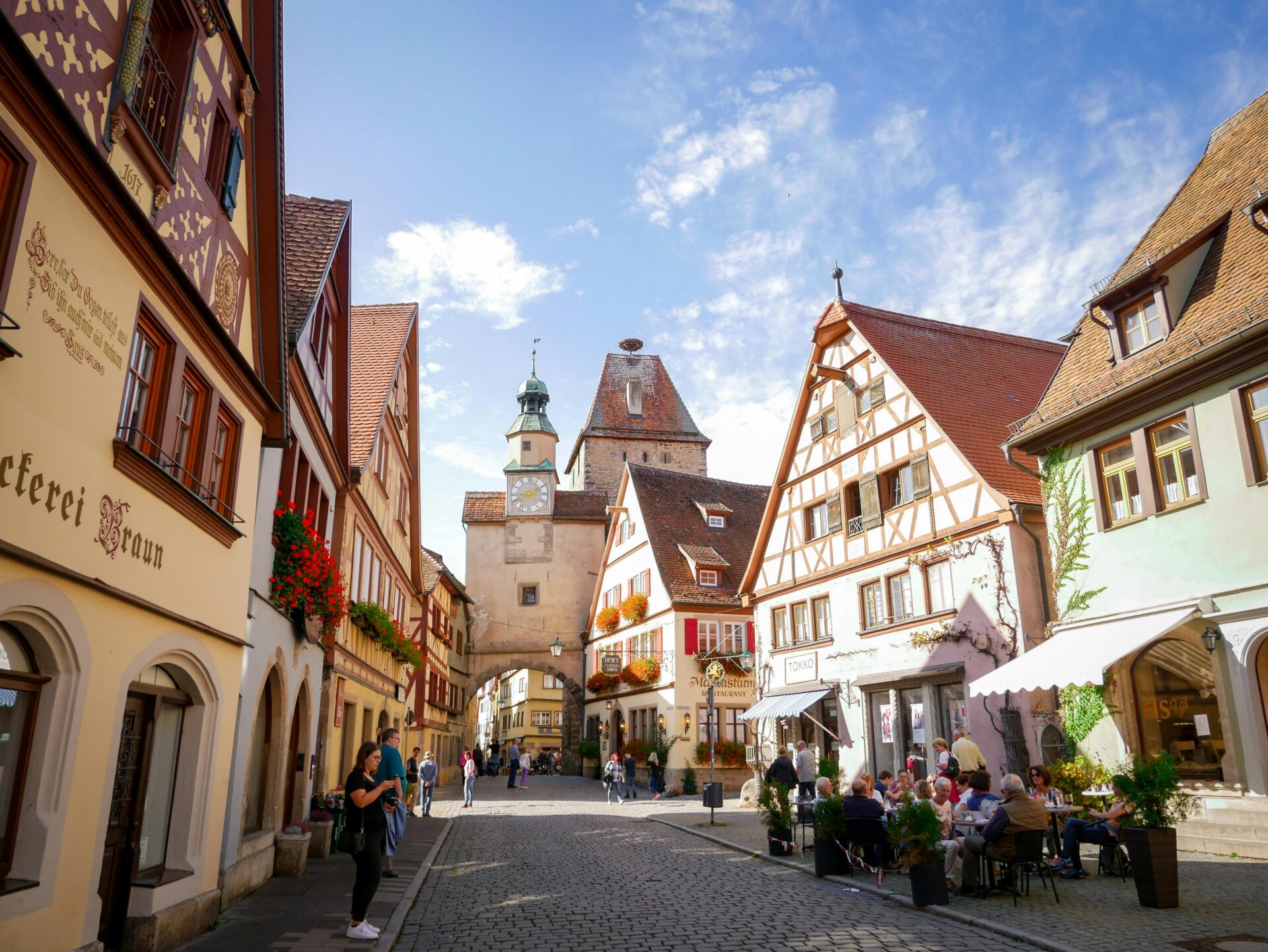
Festive Spirit: Christmas Markets, Schneeballen, and Seasonal Magic
During Christmas, Rothenburg lights up like a fairy tale. Streets glow, stalls overflow with ornaments, and the air smells of spiced nuts and cold winter.
You’ll find unique shops and a market that feels like it’s straight from the past.
Reiterlesmarkt and Christmas Village Experiences
The Reiterlesmarkt is the heart of Rothenburg’s holiday season. Every December, the town transforms as a classic Christmas village pops up in the main square.
Stalls brim with regional foods, roasted chestnuts, and handmade gifts.
Brass bands play soft music that echoes between the old buildings. My favorite time is twilight, when lanterns and strings of lights make the medieval streets glow.
I could honestly spend hours here, sipping mulled wine and browsing for wooden toys or wool mittens.
Getting to Rothenburg is pretty simple—public transportation connects it to big cities like Frankfurt or Munich. The train station is just a short walk from the old town, so arriving is easy.
Hotels and guesthouses fill up fast during market time, so I always try to book early.
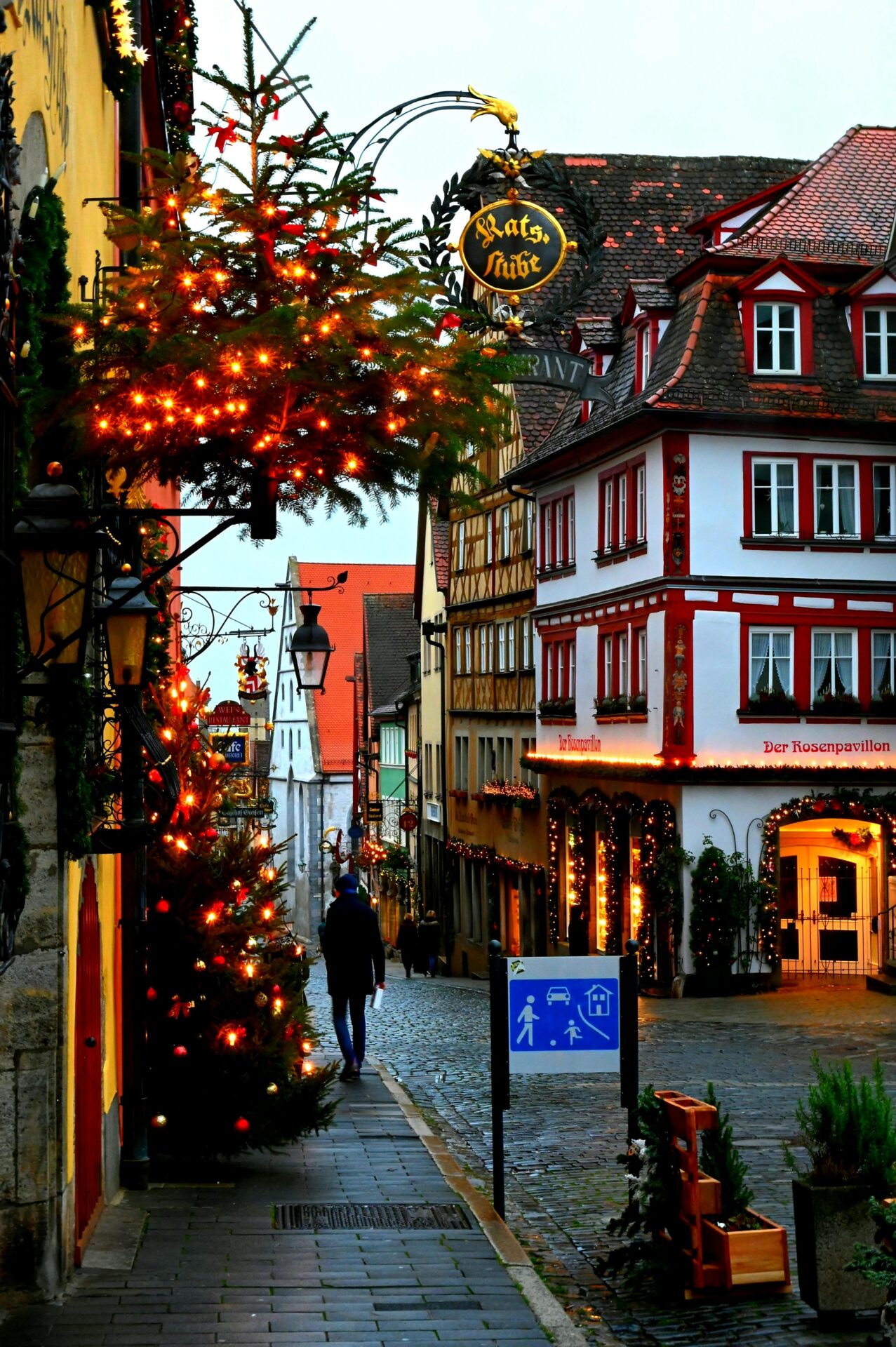
Tasting the Famous Schneeball Pastries
You can’t visit Rothenburg without trying a schneeball. This local pastry looks like a snowball and is made from strips of shortcrust dough, deep-fried until crisp.
The classic version is dusted with powdered sugar, but I’d say try the chocolate or nut-covered ones too.
Bakeries all over the old town display these treats, especially in winter. I like to grab a fresh schneeball with hot chocolate and watch people bustle around the market square.
It’s fun to share, and most shops sell boxes if you want to bring some home.
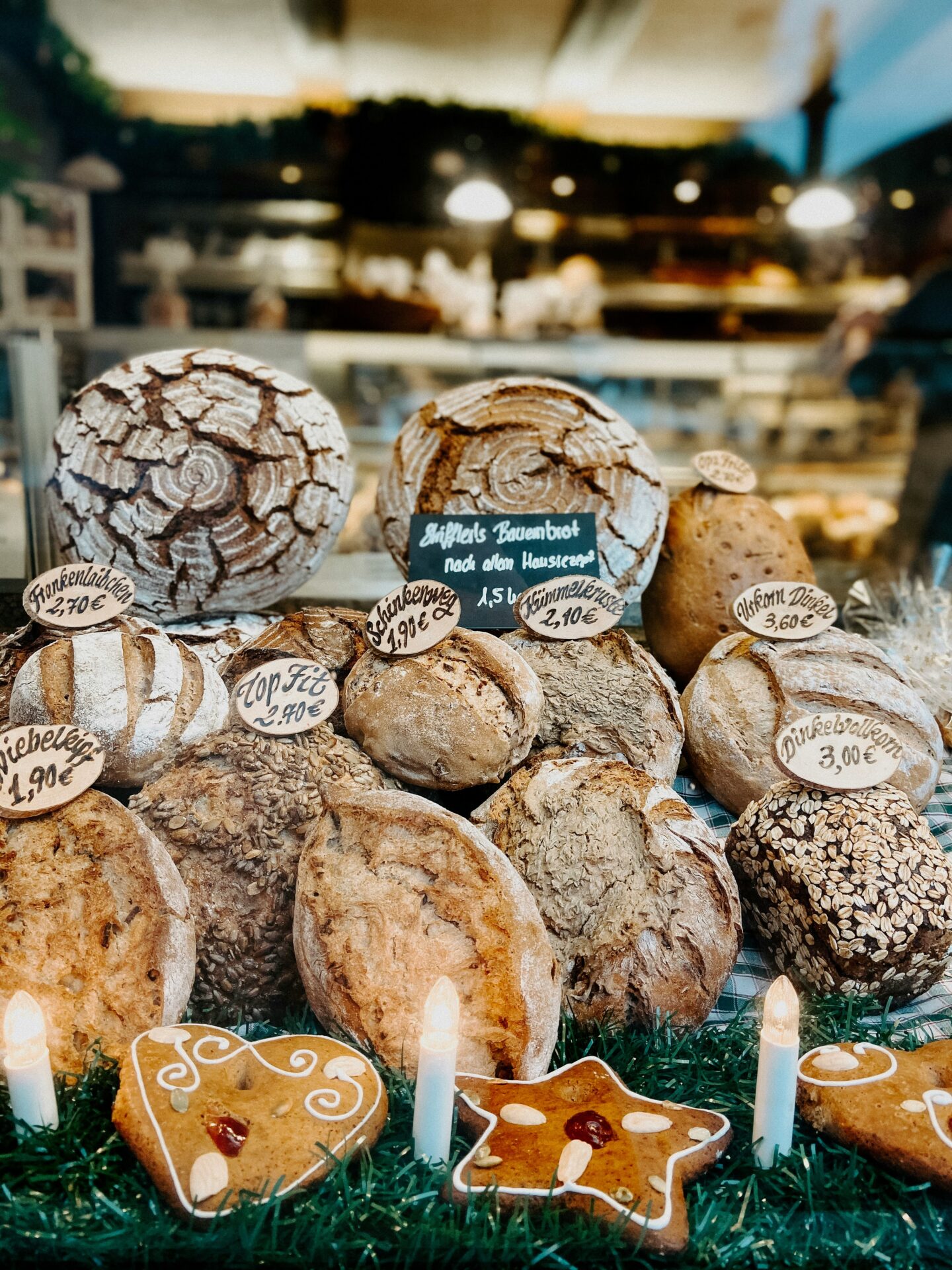
Käthe Wohlfahrt and Christmas Shopping
Rothenburg has a spot that draws people in all year: Käthe Wohlfahrt, the legendary Christmas store in Germany.
The main shop? It’s a wonderland. You’ll see nutcrackers, wooden pyramids, and hand-painted ornaments everywhere.
Even if it’s not December, I can’t help but get swept up in the festive vibe.
Right next door, the German Christmas Museum shows off holiday traditions and old-school decorations.
I usually pop in for a quick look, especially when I’m curious about how holiday customs have shifted over time.
Shopping at Käthe Wohlfahrt makes picking out souvenirs surprisingly easy.
Sometimes I’m after a glass ornament, other times a classic wooden angel—either way, it’s hard to go wrong.
When it comes to practical shopping, I try to carry small breakables in my backpack.
If that’s not possible, I just have them shipped home.
The staff always pack things up with care, so honestly, I haven’t had any issues getting gifts back safely.

